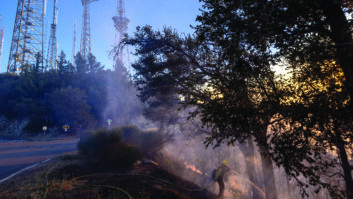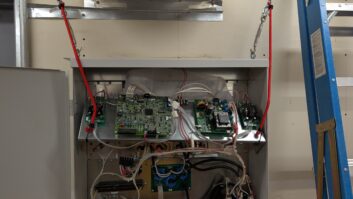figures
(click thumbnail)Fig. 1: An inexpensive solution to the problem of improperly stored caulk.
(click thumbnail)Fig. 2: Periodically tighten call breaker connections and feeder bolts — with the power off.
(click thumbnail)Fig. 3: Don’t interrupt composite signals with transformers. And clean those exciter fans.How many times have you reached for a tube of caulk, RTV or glue only to discover that the previous user did not seal and store it properly? Now the material has the consistency of concrete.
An affordable solution is as near as your jar of large “wire nuts.” Simply install one of these oversized “Hummers” on the end of the tube and you are good to go for at least another six months.
The internal screw threads of the wire nut securely fasten and seal the nut to the caulking tube tip, yet it can be unscrewed easily for use. This works better than nails, screws or even plastic wrap to seal the tube, and is inexpensive.
Washington radio veteran Bob Hughes passes this tip along to the readers of Workbench.
* * *
We’ll title this tip “strange uses for parts.”
Neil Swanson worked in the broadcast industry for many years, most recently in Minneapolis/St. Paul. He then made the leap to cellular — you know, no remotes, regular hours, weekends off, no pager.
As we all know, broadcast engineering never leaves your blood. Neil’s still a ham and reads every issue of RW.
After seeing our horror stories involving Belden 8451 audio wire used to run AC voltage, he shared an interesting encounter from early in his broadcast engineering career.
Younger readers may not realize there was a time when all stations were required by the FCC to perform and pass annual audio “proof of performance” measurements. Neil’s first proof failed. The audio system could not pass the noise spec. The chief engineer, Neil’s boss, installed an audio transformer between the composite output of a Moseley 303 STL and the composite input of the RCA FM exciter! As a fledgling engineer, Neil just watched.
The transformer took care of isolating the noise, and that measurement specification was achieved; but now, for some reason, the station could not pass the stereo proof! Let’s see if beginner engineers reading this column can figure out why. Read on.
* * *
Tampa Bay SBE member and Harris executive Hal Kneller passes along the following tip from the SBE Chapter 39 list. It comes from Bob Hardie, chief of MyTV Tampa Bay. It’s a horror story with a happy ending.
Bob’s 85 kVA UPS “power distribution panel” acted up recently. Investigation found that one of the three output phases of 120 VAC was gone.
It turned out that one of the 2/0 wires from the utility transformer to the main breakers feeding the 120 V breakers was loose. The bolt/nut evidently was not tightened properly at installation.
Six years later it loosened to the point that it was literally burning. The 1/2-inch bolt head glowed a deep red. Embers ringed the bolt like a campfire. A laser temperature probe read 758 degrees!
Using a fiberglass rod, Bob and his team wedged some metal in the connection, and the bolt head returned to normal color, while the temperature dropped significantly. This allowed continued operation, at least for a few hours while the repairs were organized.
Repairs were made after midnight, when all the power could be turned off. The damage was much more involved than had been imagined. Repair was not as simple as removing the old bolt, replacing the wires and tightening it back up. High heat melts things.
Bob writes they now use the Fluke infrared laser probes at both studio and transmitter locations. In addition to measuring electrical boxes and circuit breakers, they check cooling water pumps and even cooling fan motors. The diligence has paid off as many small problems have been detected before they could grow.
Consider Bob’s experience a big wakeup call. Warmer weather is here, which will only make this kind of heating problem worse. Electricians and some insurance companies offer an infrared camera scan. If you contract for this service and you’re an AM station, include the phasor and coupling unit components. Loose coil clips, rollers or component tubing connections will also heat and drastically change operating parameters as the problem gets more severe, not to mention destroying components.
Always good to hear from the TV folks, especially with experiences we can all relate to.
* * *
In addition to writing equipment reviews and other stories for Radio World, Ty Ford provides audio production and voiceover services (see www.tyford.com).
Ty is always on the lookout for unique products and services to help him operate more efficiently. He writes with a link for Mac users who have too much voicemail. The site details an interesting piece of free software. Go to www.apple.com and enter CallWave Visual Voicemail in the search field.
* * *
Regarding Neil Swanson’s story:
At one time or another in our careers, we’ve all probably wished for a transformer with specs from DC to light; it still hasn’t been invented.
Although inserting an audio transformer in the composite line took care of isolating noise and hum, the frequencies of the composite signal are higher than an audio transformer can pass.










